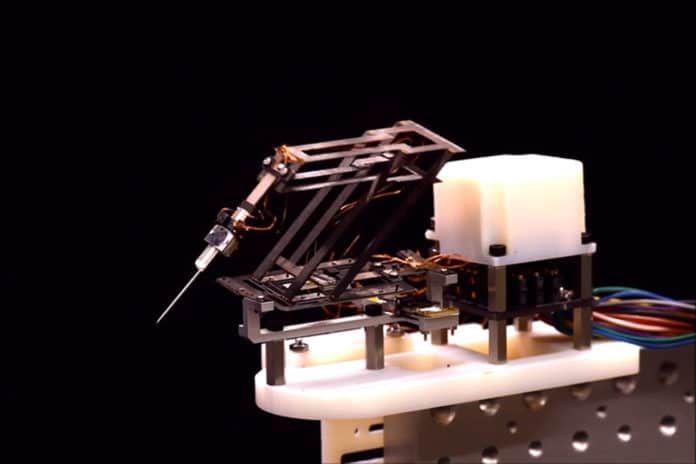Researchers from Wyss Institute at Harvard University and Sony Corporation have developed a new, origami-inspired surgical robot called the “mini-RCM” – the miniature remote center of motion manipulator. At the size of a tennis ball and weight of the same as a penny, the robot is much smaller and lighter than other microsurgical devices previously developed in academia.
Developed by a Wyss Institute Associate Faculty member, Robert Wood, Ph.D., and Robotics Engineer Hiroyuki Suzuki of Sony Corporation, the mini-RCM can handle delicate tasks on a microscopic scale. Researchers built the robot using the Pop-Up MEMS manufacturing technique developed in Wood’s lab.
In this technique, the materials are deposited on top of each other in layers that are bonded together and laser-cut in a specific pattern so they “pop-up” into their desired three-dimensional shape. The team then fabricated three linear actuators (mini-LAs) to control the robot’s movements in different directions.
Despite its small size, the mini-RCM has delivered enormous results. During the tracing test, the researchers found that this surgical robot was able to complete its task with 68% more accuracy than a hand-controlled tool.
Additionally, this mini-RCM robot also successfully performed a mock version of a surgical procedure called retinal vein cannulation, in which a surgeon must carefully insert a needle through the eye to inject therapeutics into the tiny veins at the back of the eyeball. It was able to successfully puncture a silicone tube the same size as the retinal vein without causing local damage or disruption. During the experiment that simulated this delicate intraocular surgical operation, the robot proved that it could also be used for such complex operations.
Also, thanks to its small size and light weight, the mini-RCM is much easier to set up and install than many other surgical robots, some of which can take up an entire room and are often limited to handling comparatively large tools. Besides, the robot can be easily removed from a patient’s body by hand in the case of a complication or electrical outage.
Although there is still a long way to go to see this device teleoperating real surgical procedures, its enormous advantage in terms of its precision position it as a technological invention that could be the new focus of developers.
Journal Reference:
- Suzuki, H., & Wood, R. J. (2020). Origami-inspired miniature manipulator for teleoperated microsurgery. Nature Machine Intelligence, 2(8), 437-446. DOI: 10.1038/s42256-020-0203-4
